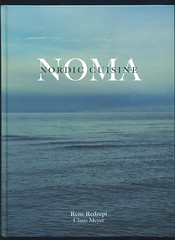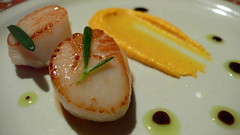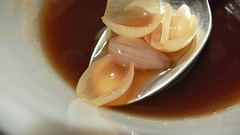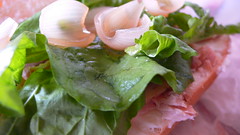 fig. a: Noma: Nordic Cuisine
fig. a: Noma: Nordic Cuisine
There's something downright exhilarating about René Redzepi and Claus Meyer's Noma: Nordic Cuisine (2006). It begins with the photographs that grace the cover and continue throughout the text. Sometimes stark (like the photo above), oftentimes almost absurdly picturesque (like this photograph),
 fig. b: landscape by Noma 1
fig. b: landscape by Noma 1
and at times even sublime, much of the impetus behind Noma's photography has to do with situating the restaurant's cuisine within Denmark's formidable landscape, and the impression one gets is of a countryside that's equal measures forbidding and abundant. Thus, alongside pictures of Greenland's desolate glaciers (what remains of them),
 fig. c: landscape by Noma 2
fig. c: landscape by Noma 2
you get pictures of lovable old Danish hippies carefully collecting herbs
 fig. d: lovable old Danish hippie
fig. d: lovable old Danish hippie
that may very well end up on Noma's artfully composed plates--in this case, Hay-baked Celery Root, Black Pudding and Yellow Archangel, the first of the book's winter recipes.
 fig. e: Hay-baked Celery Root, Black Pudding and Yellow Archangel
fig. e: Hay-baked Celery Root, Black Pudding and Yellow Archangel
The thing is, according to Noma's philosophical outlook, Greenland's glaciers and southern Denmark's countryside don't form the strict binary opposition one might think they do. Where others see mountains of ice creeping across the landscape, the folks at Noma see "a rich flora and fauna, with crowberries, reindeer, grouse and musk ox." Bounty is in the eye of the beholder.
Now, if you've noted a little Nordic Pride in my description of the Noma cookbook, you're definitely onto something. Already, when the restaurant first began to take shape, there was the idea that a restaurant housed in an old warehouse that had once been part of the Royal Greenland Trade Enterprise and that would soon be the new site of the Nordatlantens Brygge (North Atlantic House) should have a vision that was pan-Nordic in orientation. But over the next nine months, in the lead-up to the restaurant's launch, Noma's vision really took on form. For one thing, Claus Meyer, the owner, and René Redzepi and Mads Refslund, the restaurant's two chefs at the time, took an extensive trip across the north, including jaunts to the Faroe Islands, Iceland, and Greenland, to search for ingredients and begin the process of making the contacts necessary to establish an alternative to the distribution networks available back in Copenhagen. The trip was a revelation, exceeding all expectations, and immediately the three "gastronomic explorers" knew they were onto a good thing, even if it might mean a lot of extra work.
By the time they returned to Copenhagen and began to work in earnest on what would become Noma's cuisine their vision had begun to develop into a full-fledged philosophy. Among its central tenets: take the Mediterranean notion of terroir, as well as the cultivation of biodiversity and the celebration of seasonality that goes along with it, and use it to utterly reject Southern European cuisine and its dominance of fine dining internationally. In other words, develop a cuisine "built on a basis of traditional and non-traditional Nordic ingredients," as Claus Meyer noted after one early planning meeting, one that would give "expression to the seasons' changes in a maximum way, taking things all the way to the limit." By March 2004, just four months into Noma's life, this sort of feistiness, this proudly anti-Mediterranean attitude, was already paving the way to the Nordic Cuisine Symposium, where in true Danish fashion--this is the same country, after all, that gave birth to Dogme 95--they banged together a 10-point manifesto that set the parameters for this New Nordic Cuisine. There were twelve signatories to this manifesto, representing Denmark, Sweden, Norway, Finland, Iceland, and Greenland, and René Redzepi's signature stands front and center.
 fig. f: manifesto for a New Nordic Cuisine
fig. f: manifesto for a New Nordic Cuisine
Anyway, there's a lot here that appeals to us here at "...an endless banquet": seasonality and a focus on indigenous ingredients, Nordic pride and the development of a cuisine that's both innovative and steeped in tradition and that truly represents the region, and, yes, even a manifesto. We've said it before and we're going to say it again: for all the talk about Montreal's "European" flavor, this city, this province, is often at its best when it readily acknowledges its peculiar Nordic character (let's not forget that Montreal is at roughly the same latitude as Milan). Noma: Nordic Cuisine offers a virtual blueprint for how to develop a region's cuisine, how to create a cuisine that truly reflects the terroir, and how to do this within the context of a northerly climate.*
That said, Noma: Nordic Cuisine did present us with a couple of problems. First of all, I would characterize it as being one of those cookbooks that's more interested in spreading the reputation of a particular restaurant and its chef and in communicating with other top chefs than it is in communicating with the amateur. There's nothing necessarily wrong with this approach, of course, but it often results in vagueness when it comes to articulating recipes, and that's certainly the case with Noma. Take the Hay-Baked Celery Root recipe, for instance, which begins like this: "Light the hay with a match, some place away from the kitchen, and burn off the first bit of smoke." The ideas are there, and they're frequently brilliant, but you might have to be a chef (or a psychic) to figure out how to bring them to life. Secondly, Noma's tireless efforts when it came to tracking down indigenous Nordic ingredients means that quite a few of the recipes are impossible to replicate without access to their alternative distribution networks. It might be a little difficult to find local sources for musk ox, yellow archangel, and seakale, but Noma certainly leaves you with the desire to broaden your repertoire of regional and indigenous ingredients, and, overall, there's a surprising amount of overlap between the seasonal specialties there and here: fiddlehead ferns, lobster, hare, jerusalem artichokes, oysters, pears, ramps, and so on.
When it came to actually putting Noma: Nordic Cusine to use, however, we started off very tentatively. Michelle took elements from a couple different recipes and paired them, creating a new breakfast combo all her own. The first was a wonderful spice bread recipe, one that had that exact Northern European spice bread flavor that Michelle had been seeking but had otherwise failed to find. The second was a novel and, quite frankly, ingenious approach to the poaching of an egg, one that allowed for the egg to be aromatized as it cooks--in this case with white truffle oil.** She then added a caramelized scallion as a finishing touch.
 fig. g: spice bread, truffled egg, caramelized scallion
fig. g: spice bread, truffled egg, caramelized scallion
Spice Bread (metric)
5 g cinnamon
5 g clove
2 g nutmeg
2 g green anise
150 g rye flour
150 g wheat flour
20 g baking powder
50 g wholewheat flour
100 g honey, preferably chestnut honey
150 g maple syrup
125 g whole milk
125 g eggs
fresh rosemary
butter and salt
Preheat the oven to 160º C. Mix the dry ingredients together in a bowl. Crush the spices and sift them over the dry ingredients. Stir in the honey and maple syrup, then the milk, and finally the eggs. Place in a buttered loaf pan and bake until a knife inserted in the center comes out clean, about 45 min. Let cool on a rack.
Spice Bread (imperial)
1 1/2 cups rye flour
1 1/2 cups all purpose flour
1/2 cup whole wheat flour
1 tbsp baking powder
2 tbsp cinnamon
2 tbsp cloves
1 tbsp nutmeg
1 tbsp green anise
1/3 cup + 1 Tbsp honey
1/2 cup maple syrup
1/2 cup milk
2 whole eggs
1 egg yolk
Preheat the oven to 325° F. Mix the dry ingredients together in a bowl. Crush the spices and sift them over the dry ingredients. Stir in the honey and maple syrup, then the milk, and finally the eggs. Place in a buttered loaf pan and bake until a knife inserted in the center comes out clean, about 45 min. Let cool on a rack.
Truffled eggs
1 egg per person
truffle oil
microwaveable plastic wrap
The basic method is as follows. Line a coffee cup with a small piece of plastic wrap, making a bowl. Take a small amount of truffle oil and spread it on the bottom. Carefully break an egg into the cup, gather the edges of the plastic up around the egg and twist it tightly closed. Secure it with twine or a twist tie. Repeat with as many eggs as are needed. Bring a small saucepan of water to simmer and maintain its temperature. Drop the eggs into the water and let them poach about 4 minutes. Carefully remove them from the water and gently take off the plastic wrap.
[both recipes from Noma: Nordic Cuisine]
To serve:
Lightly toast the bread and spread it with butter. Top with an egg and a caramelized scallion, season with salt and pepper, and enjoy.
This initial experiment having turned out a smashing success (if a modest one), we decided to take bigger steps with
Noma: Nordic Cuisine the next time around.
To be continued...
am/km
P.S. If you'd like to read an actual firsthand account of what it's like to dine at Noma (complete with a whole slew of beautiful photographs)--which just received two Michelin stars in their
Main Cities of Europe 2008 guide--check out
Very Good Food's in-depth
report.
P.S. 2 May 4, 2008: Now
The New York Times has published a review of Noma as part of a piece on New Danish Cuisine in Copenhagen. Check it out
here.
* More thoughts on cuisine and
le grand nord: Just two week ago I attended a conference where one of the presenters, a local poet, waxed poetic (what else, right?) about Quebec's essentially Northern spirit, about the Idea of North that lies at the heart of Québécois culture. Well, as much as I wish this were true on some level, I couldn't help but think that the same culture that declared "Mon pays c'est l'hiver" some forty years ago, has spent the last 50-60 winters focusing its collective energies and fantasies southwards, towards places like Florida and Las Vegas. And, frankly, cuisine here in
la belle province oftentimes suffers from the same fixation, which is why Montreal's standout restaurants are the ones that are the most fiercely independent, the ones that recognize that not only does it pay to support local and regional producers, doing so can be a source of inspiration and a sure-fire way to put yourself on the map. Does this mean we're advocating some kind of entrenched provincialism when it comes to cuisine? Of course not, but if you're going to transpose the cuisine of northern Italy or of southwestern France on the Québécois milieu, why not transpose the strong sense of
terroir that goes hand-in-hand with those traditions?
** "Whoa! White truffle oil?!? Isn't that as Mediterranean as it comes?" Not at all. Locally harvested truffles figure prominently on Noma's autumn menu. Of course, the truffle we used was Italian, but that's another matter. Those fabulous Tennessean truffles we've been hearing about haven't made their way north in the form of truffle oil yet, to our knowledge.
 fig. a: curling scene, Montreal
fig. a: curling scene, Montreal fig. b: old-school
fig. b: old-school fig. c: new-school
fig. c: new-school fig. d: Krogstad Aquavit
fig. d: Krogstad Aquavit fig. e: proof of E.S.P.
fig. e: proof of E.S.P.





















